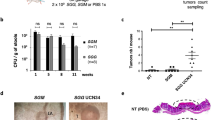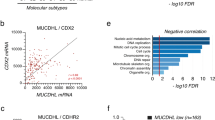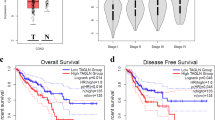Abstract
Clusterin is a ubiquitous secretory heterodimeric disulfide-linked glycoprotein, which is implicated in several physiological processes, including immune regulation, cell adhesion and morphological transformation, lipid transportation, tissue remodelling, membrane recycling and cell–cell interactions. A large number of studies have focused their interest on clusterin gene products as mediators of cell cycle progression and cell death induction, although data on the different isoforms and their role in the different cell processes are still obscure. Recently, an increased clusterin expression in breast cancer has been reported. In order to elucidate the role of clusterin in tumor progression and whether one of its isoforms is preferentially expressed in tumorigenesis, we examined its presence throughout the different steps of human colon carcinoma, one of the best-characterized models of human tumor progression. The immunohistochemical observation of 30 bioptic and surgical colon specimens demonstrated a cell compartment clusterin translocation from the nucleus to the cytoplasm directly related to tumor progression. In fact, a nuclear localization found in healthy colonic mucosa is consistent with the involvement of the proapoptotic nuclear form in the regulation of cell cycle progression and in cell death induction. The progression towards high-grade and metastatic carcinoma leads to cytoplasmic clusterin distribution. Protein extracts from freshly isolated cells of the same patients confirm in high-grade carcinomas with metastatic nodes the complete loss of the proapoptotic nuclear form and a cytoplasmic overexpression of the highly glycosylated form. Data obtained from in vitro experiments confirm that this form is released in the extracellular space and corresponded to the fully glycosylated one. These data suggest that the controversial data on clusterin function in tumors may be related to the pattern shift of its isoform production. As the secreted form of clusterin is correlated to cell matrix formation, cell membrane remodeling and cell–cell adhesion, the overexpression of this form in highly aggressive tumors and metastatic nodes could be a potential new prognostic and predictive marker for colon carcinoma aggressiveness.
This is a preview of subscription content, access via your institution
Access options
Subscribe to this journal
Receive 50 print issues and online access
$259.00 per year
only $5.18 per issue
Buy this article
- Purchase on Springer Link
- Instant access to full article PDF
Prices may be subject to local taxes which are calculated during checkout






Similar content being viewed by others
References
Andrews NC and Faller DV . (1991). Nucl. Acid. Res., 19, 2499.
Aronow BJ, Lund DS, Brown TL, Harmony JAK and Witte DP . (1993). Proc. Natl. Acad. Sci. USA, 90, 725–729.
Bandyk MG, Sawczuk IS, Olsson CA, Katz AE and Buttyan R . (1990). J. Urol., 143, 407–413.
Bettuzzi S, Scorcioni F, Astancolle S, Davalli P, Scaltriti M and Corti A . (2002). Oncogene, 21, 4328–4334.
Burkey BF, DeSilva HV and Harmony JA . (1991). J. Lipid Res., 32, 1039–1048.
Dignam JD, Lebovitz RM and Rorder RG . (1983). Nucl. Acid. Res., 11, 1475–1489.
Fratelli M, Galli G, Minto M and Pasinetti GM . (1996). Biochim. Biophys. Acta, 1311, 71–76.
French LE, Sappino AP, Tschopp J and Schfferli JA . (1992). J. Clin. Invest., 90, 1919–1925.
Ho SM, Leav I, Ghatak S, Merk F, Jagannathan VS and Mallery K . (1998). Am. J. Pathol., 153, 131–139.
Humphreys DT, Carver JA, Easterbroock-Smith SB and Wilson MR . (1999). J. Biol. Chem., 274, 6875–6881.
Kyprianou N, English HF, Davidson NE and Isaaca JT . (1991). Cancer Res., 51, 162–166.
Lakins J, Bennett SA, Chen JH, Arnold JM, Morrissey C, Wong P, O'Sullivan J and Tenniswood M . (1998). J. Biol. Chem., 273, 27887–27895.
Leskov KS, Klokov DY, Li J, Kinsella TJ and Boothman DA . (2003). J. Biol. Chem., 278, 11590–11600.
Miyake H, Hara I, Kamidono S and Gleave ME . (2001). Clin. Cancer Res., 7, 4245–4252.
Murphy BF, Kirszbaum L, Walker ID and DÁpice AJ . (1988). J. Clin. Invest., 81, 1858–1864.
O'Sullivan J, Whyte L, Drake J and Tenniswood M . (2003). Cell Death Differ., 10, 914–927.
Pucci S, Mazzarelli P, Rabitti C, Giai M, Gallucci M, Flammia G, Alcini A, Altomare V and Fazio VM . (2001). Oncogene, 20, 739–747.
Reddy KB, Karode MC, Harmony AK and Howe PH . (1996). Biochemistry, 35, 309–314.
Redondo M, Villar E, Torres-Munoz J, Tellez T, Morell M and Petito CK . (2000). Am. J. Pathol., 157, 393–399.
Rigas B, Borgo S, Elhosseiny A, Balatsos V, Manika Z, Shinya H, Kurihara N, Go M and Lipkin M . (2001). Cancer Res., 61, 8381–8384.
Wong P, Pineault J, Lakins J, Taillefer D, Leger J, Wang C and Tenniswood M . (1993). J. Biol. Chem., 268, 5021–5031.
Yang CR, Leskov K, Hosley-Eberlein K, Criswell T, Pink JJ, Kinsella TJ and Boothman DA . (2000). Proc. Natl. Acad. Sci. USA, 97, 5907–5912.
Yang CR, Yeh S, Leskov K, Odegaard E, Hsu HL, Chang C, Kinsella TJ, Chen DJ and Boothman DA . (1999). Nucleic Acids Res., 27, 2165–2174.
Zellweger T, Myake H, July LV, Akbari M, Kiyama S and Gleave ME . (2001). Neoplasia, 3, 360–367.
Zhou W, Janulis L, Park II and Lee C . (2002). Life Sci., 72, 11–21.
Author information
Authors and Affiliations
Corresponding authors
Rights and permissions
About this article
Cite this article
Pucci, S., Bonanno, E., Pichiorri, F. et al. Modulation of different clusterin isoforms in human colon tumorigenesis. Oncogene 23, 2298–2304 (2004). https://doi.org/10.1038/sj.onc.1207404
Received:
Revised:
Accepted:
Published:
Issue Date:
DOI: https://doi.org/10.1038/sj.onc.1207404
Keywords
This article is cited by
-
Clusterin: a marker and mediator of chemoresistance in colorectal cancer
Cancer and Metastasis Reviews (2024)
-
Zinc Acts Synergistically with Berberine for Enhancing Its Efficacy as an Anti-cancer Agent by Inducing Clusterin-Dependent Apoptosis in HT-29 Colorectal Cancer Cells
Biological Trace Element Research (2023)
-
RETRACTED ARTICLE: Exploring the Role of CLU in the Pathogenesis of Alzheimer’s Disease
Neurotoxicity Research (2021)
-
Clusterin silencing restores myoblasts viability and down modulates the inflammatory process in osteoporotic disease
Journal of Translational Medicine (2019)
-
Resveratrol, an activator of SIRT1, improves ER stress by increasing clusterin expression in HepG2 cells
Cell Stress and Chaperones (2019)



